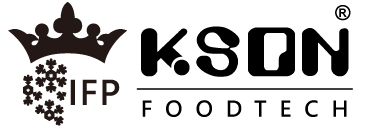Food Tempering
Frozen Food Tempering in King Son Convertible IFP Superchilling Thawer: below the initial freezing point and is usually between -5°C/23.00℉ to -2°C/28.40℉ for food process
-
Tempering is the process of taking a food product to a temperature where a substantial amount of the water in the product is in the form of ice but not all the water has turned to ice. This temperature must be below the freezing point and is usually between -5°C/23.00℉ to -2°C/28.40℉. At this state the product is rigid, but not hard, and thus easier to cut, slice process. The tempered product may either be cooled to this state from a temperature above the freezing point or warmed from a frozen temperature.
-
Unless tempering is controlled well, product variability is liable to be high. Quite small differences in temperature during processing operations such as pre-breaking or cutting can have quite large effects on product quality. The consequences of processing below the zone of optimum temper (under-tempering) may be blade breakage and yield loss from shattered product, excessive fines, and slices of non-uniform thickness. The consequences of over-tempering may also be in the form of yield loss from ragged edges and incomplete shearing of tissue resulting in pearling.
-
Sausage manufacture Principles and practice
-
Meat storage temperature and conditions should be specified, since it is often received in frozen blocks at -18°C/-0.40℉ to -22℃/-7.60℉. Meat is often stored in chillers over-night for tempering to achieve -5°C/23.00℉.
-
-
Improving dry sausage quality by controlling temperature and humidity
-
Temperature considerations
-
Temperature considerations for dry sausage are usually focused on temperatures used for the drying process, but it's important to realize that temperature effects on product quality actually begin with the raw meat used for product formulation. Meat must be kept very cold during grinding, mixing and/or chopping to avoid fat smearing, which can form a film of fat over the lean tissue and reduce the movement of water out of the product. Meat should be maintained at -2 degrees C to -4 degrees C (24 degrees F to 28 degrees F) to facilitate good fat/lean distinction and allow effective moisture migration.
-
Avoiding fat smearing during stuffing is also important, particularly because a film of fat just under the casing can dramatically slow the migration of water out of the product. So, again, temperature becomes an important consideration and should not exceed -1 degrees C to 0 degrees C (30 degrees F to 32 degrees F) during stuffing. Using large-diameter, short-length stuffing horns can also minimize fat smearing in dry sausage.
-
-
Humidity considerations
-
Relative humidity first becomes a consideration for fermentation when at least 90 percent is recommended and 95 percent or more is often used.
-
-


